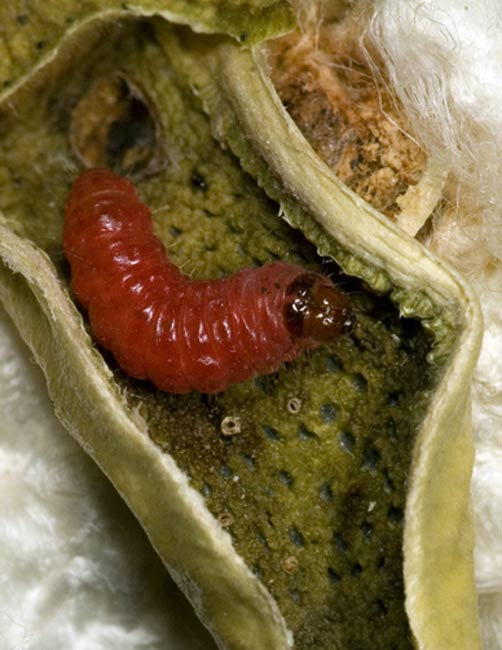Insect Birth Control Targets Cotton Pests

A birth control program for destructive pink bollworms that wreak havoc on cotton crops has virtually eliminated the cotton pests in Arizona. That approach, in combination with planting pest-resistant cotton, has allowed growers to maintain high cotton yields without spraying insecticides.
Genetically engineered cotton usually kills off most of the hungry bollworms, but leaves a resistant band of survivors that can quickly repopulate. Researchers have countered by releasing large numbers of sterile moths to mate with the resistant survivors, so that they don't leave any offspring.
"We are running the pesticide treadmill in reverse," said Bruce Tabashnik, department head of entomology at the University of Arizona. "Our new approach has resulted in huge environmental gains. We are using cutting-edge technology to create sustainable cotton farming practices."
The new approach is part of a broad team effort to eradicate pink bollworm from the southwestern United States and Mexico, in which Tabashnik and his coauthors play a leading role. Their latest work is detailed in the Nov. 7 online publication of the journal Nature Biotechnology.
War in the cotton fields
Caterpillars of the pink bollworm (Pectinophora gossypiella) are one of the most detrimental pests to cotton production worldwide. First detected in the United States in 1917, this invasive insect species wreaked havoc on Arizona's cotton growing industry.
A breakthrough came in 1996 with the introduction of Bt cotton, a genetically engineered crop containing a gene transferred from the bacterium, Bacillus thuringensis, endowing the plants with a protein that kills some, but not all, insects. Unlike typical broad-spectrum insecticides, which kill most insects, pests or not, the Bt toxin only targets certain insect species. Pink bollworm caterpillars munching on Bt cotton die before becoming adults and therefore do not reproduce.
Get the world’s most fascinating discoveries delivered straight to your inbox.
Bt crops have allowed farmers to cut back on spraying, but, much like antibiotics, have suffered from pests evolving resistance to the toxins. Such resistance can sometimes arise very rapidly.
Tabashnik was the first to discover and document a case of a moth – not pink bollworm – evolving resistance to Bt toxins in crop fields.
Refuge for genes
"The most widely used strategy to delay resistance is to set aside refuges," Tabashnik explained, "patches with regular, non-Bt cotton where the pest can feed without ingesting the Bt toxin."
The refuges ensure a substantial population of non-resistant insects will still be fluttering about in search for mates. Given the abundance of non-resistant insects relative to the scarce resistant ones, chances are slim that two resistant moths will mate with each other.
Instead, most, if not all, resistant moths will mate with a susceptible partner. Since the trait for resistance is recessive (and so you need two copies of that gene for resistance to show up), hybrid offspring from a cross between resistant and susceptible moths will end up susceptible.
While the refuge concept has worked reasonably well at keeping the pests at bay, it is incompatible with eradication, Tabashnik pointed out.
"Refuges are a way of managing pest populations, so you have to accept the permanent presence of the pest," he said. "You don't get rid of them. You maintain susceptibility by promoting survival of the susceptible insects."
Sterile but single
Rather than relying on susceptible moths from refuges to thwart resistance, the eradication program staff raised large numbers of pink bollworms, sterilized them, and released the sterile moths into cotton fields where they could block reproduction of the wild insects.
"When a sterile moth mates with a fertile wild moth, the progeny won't be fertile," Tabashnik said. "The sterile insects soak up the reproductive potential of the wild population. If you have a high enough ratio of sterile to wild moths, you can drive the reproduction of the wild population to zero."
The release of sterile insects to control pests is not new. But this is the first time the sterile insect technique has been used in concert with a Bt crop.
A limitation of the sterile release strategy is that extremely large numbers of sterile insects can be necessary to block reproduction of the wild population, according to Tabashnik. "It becomes a question of logistics: Can you deliver enough sterile insects to overwhelm the wild population?"
But in combination with planting Bt cotton, the strategy turned out to be extremely powerful, Tabashnik's group discovered since tests started in 2006. Tabashnik explained: "On the Bt cotton, pink bollworm survival is virtually zero. This makes it much easier to overwhelm the wild population."
Bollworm-buster success
Since the eradication program began, pink bollworm populations have fallen dramatically. In 2009, only two pink bollworm larvae were found in 16,600 bolls of non-Bt cotton screened across the state. From 2005 to 2009, the pink bollworm infestation rate dropped by 99.9 percent.
Along with the decline, insecticide sprays fell to historic lows. Arizona cotton growers lost $18 million per year to pink bollworm management between 1990 and 1995, but that cost plummeted to an average of $172,000 per year between 2006 and 2009.
Compared with 1995, Arizona growers' insecticide use against all cotton pests, including those not killed by Bt cotton, decreased by 88 percent, saving $200 million in insecticide costs between 1996 and 2009.
The eradication program and associated research is a partnership among the growers, their organizations, the USDA and the University of Arizona (UA), including Peter Ellsworth of the UA's Cooperative Extension Service.



